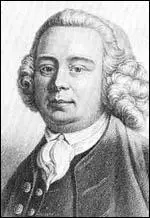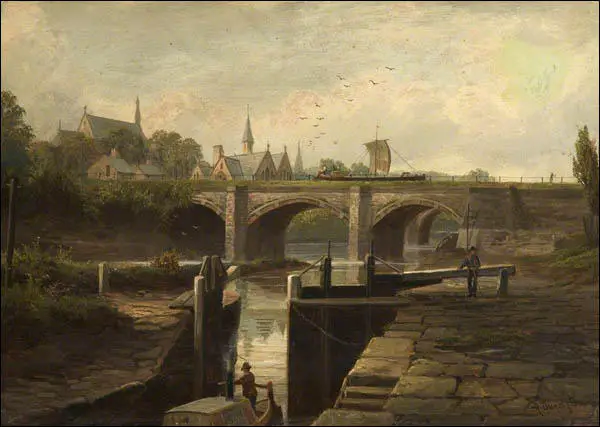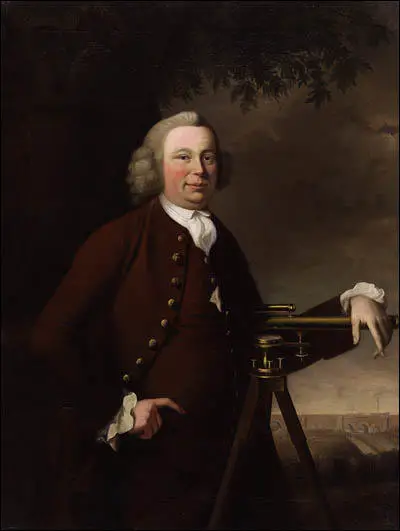James Brindley

James Brindley, the eldest of seven children of James Brindley and his wife, Susannah Bradbury Brindley, was born at Tunstead in 1716. Samuel Smiles claims that his mother was an important figure in his early life: "Brindley's father... neglected his children, not only setting before them a bad example, but permitting them to grow up without education. Fortunately, Brindley's mother in a great measure supplied the father's shortcomings; she did what she could to teach them what she knew, though that was not much; but perhaps more important still, she encouraged them in the formation of good habits by her own steady industry". (1)
In December 1727, his father inherited a farm near Leek in Staffordshire. Brindley did local labouring job but he showed an interest in mechanical work, and at the age of seventeen began a seven-year apprenticeship with Abraham Bennett, a millwright and wheelwright at Sutton near Macclesfield. "At first he was regarded as a bungler by Bennett, but he was to become Bennett's right-hand man after his work on a silk mill at Macclesfield, and at a paper mill at Wildboarclough, where he saved the firm's professional reputation." (2)
Brindley remained with Bennett after his apprenticeship ended, running the business until his employer's death in 1742. He then established as a millwright in his home town. Despite his lack of education Brindley developed a reputation for his knowledge of mills and water and his interest in engineering and was often asked for advice by local landowners about improvements to machinery. (3)
James Brindley - Millwright
This was successful and in 1750 he set up a second workshop at Burslem, in property leased from the Josiah Wedgwood family. During the next ten years he worked on several water and wind mills. Brindley became interested in steam power and installed several atmospheric engines. His most ambitious project was the drainage scheme he installed at the Wet Earth colliery at Clifton near Manchester. Brindley took water from the River Irwell through an underground tunnel over 800 yards long that ran under the river to drive an overshot wheel, which pumped out the mine. This success emphasized Brindley's engineering skills and his understanding of hydraulic problems. (4)
It is claimed that he was not well-rewarded for this work: "Brindley never seems, during the early part of his career, to have earned more than about one-third the wage of skilled mechanics in our own time (1864); and from the insignificant sums charged by him for expenses, it is clear that he was satisfied to live in the fashion of an ordinary labourer. What modern engineers will receive ten guineas a day for doing, he with his strong original mind, was quite content to do for two shillings." (5)
Bridgewater Canal
Early in 1758 Brindley was hired to survey a canal to link Liverpool and the Mersey with the potteries and the Trent. Although construction did not begin for over eight years, this survey, brought him to the attention of Francis Egerton, the Duke of Bridgewater, who owned a large coal-mine at Worsley. The main market for his coal was the fast-growing town of Manchester. The roads between Worsley and Manchester were so bad that Bridgewater had to use pack-horses instead of wagons. As each horse could only carry 3 hundredweight (cwt) of coal at a time, this was a very expensive form of transportation. (6)
In 1759, John Gilbert, one of Bridgewater's workers, suggested that a solution to this problem would be to cut a canal between Worsley Colliery and Manchester. Gilbert pointed out, that one horse could pull over 400 cwt of coal at a time when it was carried on a barge. Bridgewater liked the idea, and after gaining permission from Parliament gave instructions for the building of the Bridgewater Canal. (7)
As Gavin Weightman, the author of The Industrial Revolutionaries (2007), has pointed out: "As there had been no tradition of canal-building before the 1750s, the engineers who took on the task had to learn new engineering skills - surveying the ground, determining the best course for the water and planning where locks and tunnels might be needed. In the eighteenth century the experts in the use of large-scale machinery were mostly millwrights - it was they who knew about cogs and gears and harnessing water power." (8)
Brindley was the obvious person to recruit for the project. He was not only a millwright but someone who had some knowledge of canals. Brindley had to get permission from Parliament to build the canal. During one session with the politicians he took out a block of Cheshire cheese and carved out a model of how his waterway would work. "It's not clear if he cut it into pieces and put it in water to illustrate how waterproof troughs worked or if he carved arches to show how an aqueduct could work." (9)
It took Brindley eighteen months to build the ten-mile canal. To keep it level it had to be taken through tunnels, along newly raised embankments, and along aqueducts such as the two hundred-yard stretch of Barton Bridge above the river Irwell. (10) Its arch was built of masonry and it carried a layer of puddled clay, four feet thick, in order to waterprrof the bed of the canal. It was described as "one of the wonders of the age". (11)

According to the record books Brindley was paid 2s.6d. a day for his work, but by the end of the project it was raised to 3s.6d. a day. (12) One observer commented that Brindley was "as plain a looking man as one of the boors of the Peake, or one of his own carters, but when he speaks, all ears listen, and every mind is filled with wonder, at the things he pronounces to be practicable." (13)
At Worsley Colliery, Brindley constructed a network of underground waterways. Coal could now be loaded on barges at the coal face and transported direct to Manchester. With this new canal, Bridgewater was able to reduce the cost of his coal from 7d. to 4d. per cwt. When it was completed it became Britain's first industrial canal. (14)
Bridgewater now extended his canal to the Mersey. This provided Manchester manufacturers with an alternative way of transporting their goods to the port of Liverpool. As this reduced the costs of transporting goods between these two cities from 12s to 6s a ton (20 cwt), Bridgewater had little difficulty in persuading people to use his canal. It was a "powerful signal regarding the profitability and feasibility of canals". (15)
Samuel Smiles has argued that along with James Watt, Bridgewater "contributed to lay the foundations of the prosperity of Manchester and Liverpool... the cutting of the canal from Worsley to Manchester gave that town the immediate benefit of a cheap and abundant supply of coal; and when Watt's steam-engine became the great power in manufactures, such supply became absolutely essential to its existence as a manufacturing town." (16)
Trent & Mersey Canal
The financial success of the Bridgewater Canal encouraged other business people to join together to build canals. Josiah Wedgwood, from Burslem, in Staffordshire, had been transporting his pottery by pack-horses. The poor state of the roads meant a great number of breakages. In 1766 Wedgwood and some of his business friends decided to recruit James Brindley to build the Trent & Mersey Canal. (17)
The following year Wedgwood wrote to his friend and business partner, Thomas Bentley: "I am afraid he will do too much, and leave us before his vast designs are executed; he is so incessantly harassed on every side, that he hath no rest, either for his mind, or body, and will not be prevailed upon to have proper care for his health. I think Mr. Brindley - the great, the fortunate, money-getting Brindley, an object of pity... He may get a few thousands, but what does he give in exchange? His health, and I fear his life too, unless he grows wiser, and takes the advice of his friends before it is too late." (18)
The canal began within a few miles of the River Mersey, near Runcorn and finished in a junction with the River Trent in Derbyshire. It is just over ninety miles long with more than 70 locks and five tunnels. Although the canal cost £130,000 to build, it reduced the price of transporting Wedgwood's goods from £210s to 13s 4d a ton. At the time it was described as the "greatest civil engineering work built in Britain." (19)
Joel Mokyr, the author of The Enlightened Economy: Britain and the Industrial Revolution (2009) has pointed out: "The most ambitious and costly project of the years of the Industrial Revolution was the construction of canals. In many respects, internal waterways were unglamorous projects. The technology involved was, in the main part, old and unspectacular. Canals were mostly designed for bulky, slow-moving cargoes and served mostly local transport needs, the average haul estimated at 26 miles or less. Much like turnpikes, they required parliamentary approval. They were also expensive to build and maintain, with a great deal of engineering ingenuity invested in the construction of aqueducts, embankments, bridges, locks, and tunnels." (20)

James Brindley was now a "national hero, a model of how practical genius could triumph over low birth and near literacy". (21) Brindley was employed as the principal engineer on the Coventry Canal, the Oxford Canal, and the Staffordshire and Worcestershire Canal. Brindley was the principal engineer on over ten canals in all, including the Birmingham Canal, the Droitwich Canal, the Chesterfield Canal, and the Huddersfield Broad Canal. Several other canal companies, including the Leeds and Liverpool, employed Brindley as a consulting engineer for advice about a specific problem or to check the suggestions of other engineers. (22)
Josiah Wedgwood invited Brindley to join the Lunar Society that used to meet in Birmingham. The group took this name because they used to meet to dine and converse on the night of the full moon. Other members included Matthew Boulton, Joseph Priestley, Thomas Day, John Wilkinson, Erasmus Darwin, William Small, John Whitehurst, John Robison, Joseph Black, William Withering, John Wilkinson, Richard Lovell Edgeworth and Joseph Wright. This group of scientists, writers and industrialists discussed philosophy, engineering and chemistry. (23)
Final Years
James Brindley suffered from diabetes, and his incessant work had an impact on his health. In the summer of 1772 he was forced to take to his bed. Josiah Wedgwood and Erasmus Darwin visited him daily. In the middle of the night he asked for a glass of water, drinks it and says: "That is enough - I shall need no more." He went back to sleep and nine hours later died without waking again. He was fifty-six years old. (24)
Brindley left £7,000 in his will. However, Francis Egerton, the Duke of Bridgewater, still owed him money for work he had done of the canals he commissioned. His widow, Anne Brindley, contacted Bridgewater, and asked for the money. He refused replying, "I am much more distressed for money than you." (25)
Primary Sources
(1) Samuel Smiles, James Brindley and the Early Engineers (1864)
Brindley's father... neglected his children, not only setting before them a bad example, but permitting them to grow up without education. Fortunately, Brindley's mother in a great measure supplied the father's shortcomings; she did what she could to teach them what she knew, though that was not much; but perhaps more important still, she encouraged them in the formation of good habits by her own steady industry.
(2) Roger Osborne, Iron, Steam and Money: The Making of the Industrial Revolution (2013)
The bill was approved in March 1759 and work began. James Brindley was brought in as engineer and proposed that the canal should cross the Irwell River on an aqueduct. The idea was ridiculed at the time but gave birth to one of the great wonders of industrial engineering. The route to Stretford was completed by 1761 and the connection with Manchester made the following year, with a tunnel carrying the coal into Deansgate in the heart of the
The duke immediately began work on taking his canal in the other direction to link it with the Mersey. Though beset with difficulties this branch, which connected Manchester to Liverpool and the sea, was opened in 1776. The Bridgewater canal was an instant success - though the duke himself had to wait decades for a return on his huge investments, the price of coal in Manchester dropped by two-thirds while people came from across the country to admire the aqueduct and tunnels. Other industrialists immediately saw the benefits of building canals and there was a scramble to get routes approved by Parliament, accelerated by fierce competition between rival groups of investors.
Josiah Wedgwood had built up a huge pottery business in Stoke and became the chief sponsor of a scheme to build a canal linking the Mersey to the Trent, which would run past his works; his chief concern was that a rival project would leave his business isolated. Typical of the entrepreneurs of the period, Wedgwood knew that he needed to go beyond the bounds of his business in order to create the necessary infrastructure.
(3) Arthur Young, Tours in England and Wales (1770)
Get rid of that dronish, sleepy and stupid indifference, that l;azy negligence, which enchains men in the exact paths of their forefathers, without enquiry, without thought and without ambition, and you are sure of doing good. What trains of thought, what a spirit of exertion, what a mass and power of effort have sprung in every path of life from the works of such men as Brindley, Watt, Priestley, Harrison, Arkwright, and let me add my fellow-traveller Bakewell! Who will tell me that the buttons at Birmingham are not better made because the tups around are better bred - because locks and sluices are better constructed, and that woolllen cloth will not be better woven because cotton is spun in the beautiful invention of the mills? In what path of life can a man be found that will not animate his pursuit from seeing the steam engine of Watt?
(4) K. R. Fairclough, James Brindley : Oxford Dictionary of National Biography (2004-2014)
During the last fourteen years of his life Brindley emerged as the man who gave shape to the English canal network, working on a number himself and training many of the engineers who completed the task of constructing the network. Before being hired by the duke, Brindley had propounded ideas for a ‘Grand Cross’, a series of canals to link the four main river estuaries, the Mersey, Trent, Thames, and Severn. The success of the Bridgewater Canal encouraged separate groups of investors to revise and implement Brindley's vision, and Brindley was to be employed as the principal engineer by all these groups, on the Trent and Mersey Canal, the Coventry Canal, the Oxford Canal, and the Staffordshire and Worcestershire Canal.
Student Activities
Child Labour Simulation (Teacher Notes)
Road Transport and the Industrial Revolution (Answer Commentary)
Richard Arkwright and the Factory System (Answer Commentary)
Robert Owen and New Lanark (Answer Commentary)
James Watt and Steam Power (Answer Commentary)
The Domestic System (Answer Commentary)
References
(1) Samuel Smiles, James Brindley and the Early Enginners (1864) page 129
(2) K. R. Fairclough, James Brindley : Oxford Dictionary of National Biography (2004-2014)
(3) Jenny Uglow, The Lunar Men (2002) page 109
(4) K. R. Fairclough, James Brindley : Oxford Dictionary of National Biography (2004-2014)
(5) Samuel Smiles, James Brindley and the Early Enginners (1864) page 143
(6) K. R. Fairclough, Francis Egerton, the Duke of Bridgewater : Oxford Dictionary of National Biography (2004-2014)
(7) George M. Trevelyan, English Social History (1942) page 400
(8) Gavin Weightman, The Industrial Revolutionaries (2007) page 42
(9) Alex Homer, BBC News (31st July 2016)
(10) John Burke, History of England (1974) page 223
(11) Barrie Trinder, Britain's Industrial Revolution (2013) page 105
(12) Samuel Smiles, James Brindley and the Early Enginners (1864) page 225
(13) Paul Longford, A Polite and Commercial People: 1727-1783 (1989) page 416
(14) Roger Osborne, Iron, Steam and Money: The Making of the Industrial Revolution (2013) page 11
(15) Joel Mokyr, The Enlightened Economy: Britain and the Industrial Revolution (2009) page 209
(16) Samuel Smiles, James Brindley and the Early Enginners (1864) page 239
(17) Jenny Uglow, The Lunar Men (2002) page 112
(18) Josiah Wedgwood, letter to Thomas Bentley (2nd March, 1767)
(19) Brian Dolan, Josiah Wedgwood: Entrepreneur to the Enlightenment (2004) page 316
(20) Joel Mokyr, The Enlightened Economy: Britain and the Industrial Revolution (2009) page 209
(21) Jenny Uglow, The Lunar Men (2002) page 117
(22) K. R. Fairclough, James Brindley : Oxford Dictionary of National Biography (2004-2014)
(23) Joel Mokyr, The Enlightened Economy: Britain and the Industrial Revolution (2009) page 49
(24) Jenny Uglow, The Lunar Men (2002) page 223
(25) Samuel Smiles, James Brindley and the Early Enginners (1864) page 227
